HTC Surround Review: A Pocket Boombox
by Brian Klug on November 13, 2010 2:01 AM EST- Posted in
- Smartphones
- Windows Phone 7
- HTC Surround
- Mobile
The front of the HTC Surround is pretty standard fare. There’s the ambient light sensor and proximity up at the top just to the right of the HTC logo, and the three required WP7 capacitive buttons at the bottom. Thank goodness that the order of buttons is standardized, from left to right: back, windows, and search. The capacitive buttons on the Surround actually work extremely well and have proved much more responsive than I’m used to them working on other devices. Perhaps because they’re spaced out and have a much larger active area. Capacitive touch on the display itself is also thankfully responsive and accurate. The entire surface is unbroken glass.
Though the Surround does not have an AMOLED display, rather just a normal TFT LCD, I found it decently contrasty in normal use on auto brightness. Unfortunately, at maximum brightness, the black levels on the Surround aren’t quite as good as other devices we’ve looked at.
| Brightness Comparison (White Point) | |||||
| Phone | Low | Medium | High | ||
| HTC Surround | 10.4 nits | 183.1 nits | 405.7 nits | ||
| LG Optimus 7 | 130.4 nits | 259.1 nits | 381.2 nits | ||
| Samsung Focus | 61.9 nits | 143.1 nits | 234.3 nits | ||
| Brightness Comparison (Black Point) | |||||
| Phone | Low | Medium | High | ||
| HTC Surround | 0.03 nits | 0.39 nits | 0.88 nits | ||
| LG Optimus 7 | 0.28 nits | 0.56 nits | 0.82 nits | ||
| Samsung Focus | 0 | 0 | 0 | ||
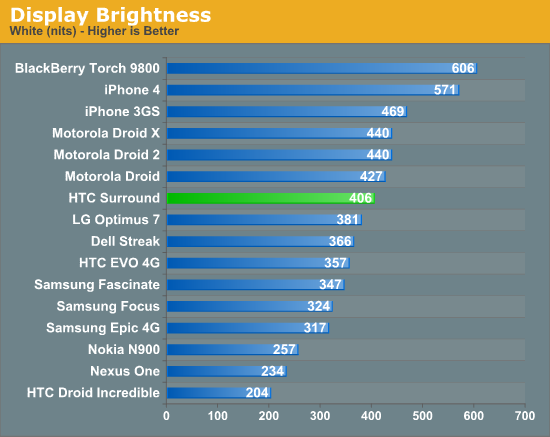
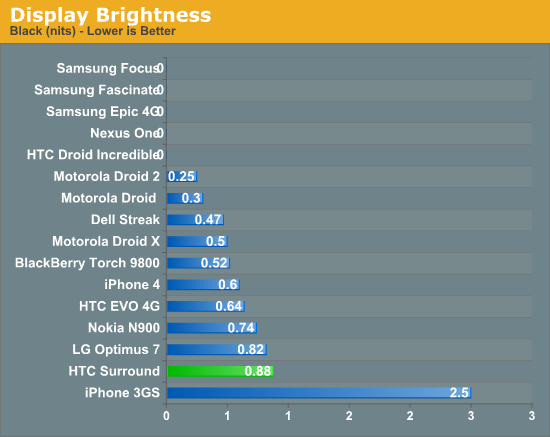
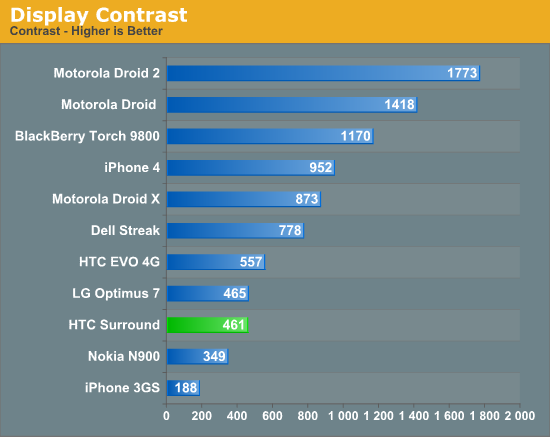
The Surround looks slightly warm next to the Fascinate, Nexus One, and iPhone 4. It's very subtle, but still detectable with the eye.
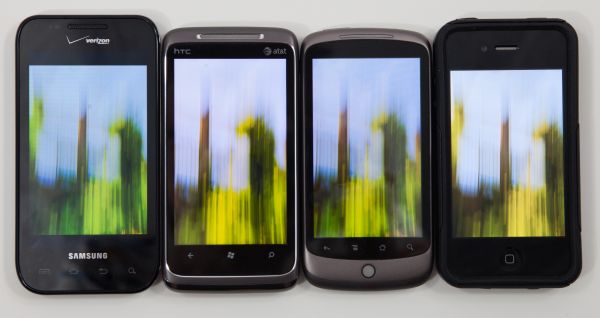
Click to enlarge (huge version)
Again, all WP7 devices are the relatively standard 800x480 WVGA resolution - the Surround’s 3.8” size gives it a fairly decent 246 pixels per inch. WP7 actually has very good subpixel font smoothing on normal LCD displays - I’m very interested in seeing if or how subpixel font smoothing is implemented on the AMOLED devices PenTile pixel matrix.
Viewing angles on the Surround are very good. Outdoor visibility is decent as well, but the Surround is noticeably more reflective than other phones. That said, it’s still more readable than the non-super AMOLED display on the Nexus One. Part of what makes the outdoor readability story on WP7 a bit different is that (unless you've changed it) most of the time you're looking at white text on black. As you've no doubt noticed in my photos so far, that makes reflection and fingerprints on the screen surface even more visible.
Auto brightness on the Surround seems to work well, however the dynamic range of brightness never seems to extend to the maximum and minimum brightnesses you can set manually. The result is that in complete darkness, the Surround isn’t dim enough. Interestingly enough, I haven’t really found myself wishing for more brightness in the converse situation.


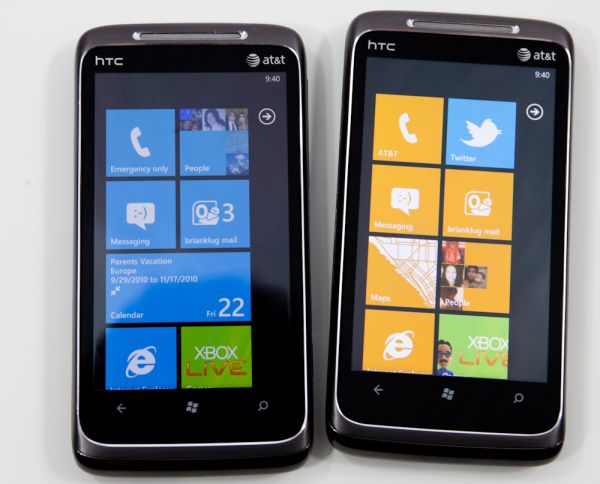






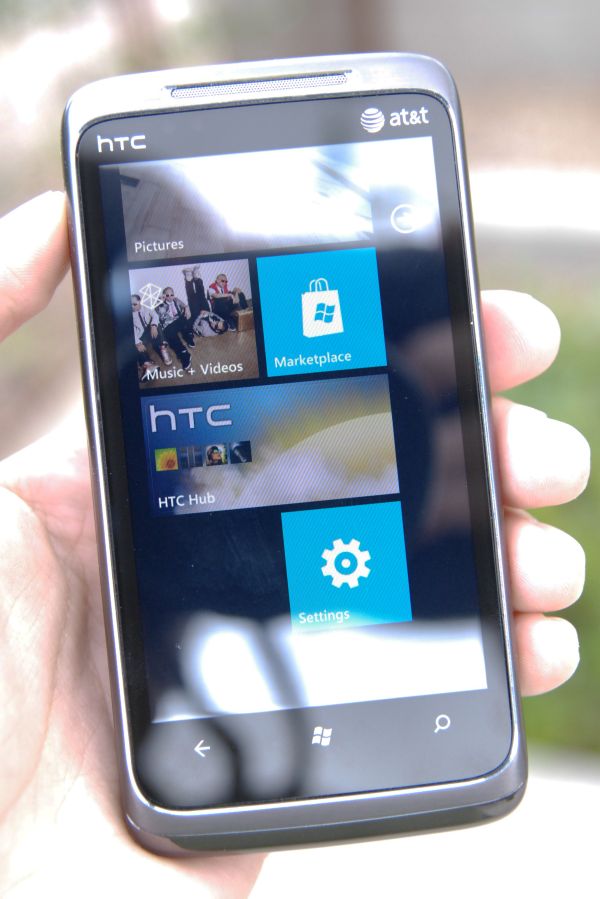








39 Comments
View All Comments
HobHayward - Saturday, November 13, 2010 - link
It's possible different cell providers include different size microSD cards.Also anandtech's spam filter is trying to not let me post this.
Anand Lal Shimpi - Saturday, November 13, 2010 - link
You are correct, fixed :)Take care,
Anand
deputc26 - Saturday, November 13, 2010 - link
I'd like to see this metric included:http://lovinitinaz.blogspot.com/2010/11/new-metric...
Meegulthwarp - Saturday, November 13, 2010 - link
I'd really like to see a comparison of the speeds the different class cards give. If installing a class 6 or 10 card vastly improves the performance of the device then I would gladly replace it but if it is only for bigger GBs then I'll pass as I'm quite happy with 8GB right now.Orange UK has an option to buy a 16GB card when you are purchasing a HTC Mozart online. Not sure what that's about as the cards aren't user replacable, might phone them up later on to ask.
bigboxes - Saturday, November 13, 2010 - link
that needs to use their headphones.*seated at the restaurant next to boxes*
OMG! Listen to this!
*giggle*
Let's play it again, but this time turn it up louder!
*boxes picks up teen's cell phone and smashes it into restaurant wall*
This is not going to replace larger sets at home and on the road (on the bus, in the grocery store line, at the restaurant, etc.) you should use headphones.
kevith - Saturday, November 13, 2010 - link
Oh yes, in my country this is already quite trendy among teenagers. It can be realyy annoying.Seems like an ok phone though, still I think we´ve only seen the beginning. As before with first desktops, then laptops, the whole race for Mhz and faster hardware can start all over again in a new formfactor, The Pockettop...
I´m 50 years old, it´s great to have lived half my life before computers entered the scen for home-users. I´m a muscician, and when I think of the things we used to dream, that computers would be able to, and what they actually are capable of today, I feel a little bit as if had been wittnessing the Wright Bros first attempts to fly.
And now - well, in a short time anyway - maybe a studio-PC to carry in your pocket.
Wonderful.
Nataku - Monday, November 15, 2010 - link
i can see some use for this though, not that i want some jerk cranking it up in a bus full of already pissed off people... lol(kids learning to dance during break time some where down the hall might be one good application for this)
NYHoustonman - Saturday, November 13, 2010 - link
What the hell is that noise D:banvetor - Saturday, November 13, 2010 - link
Dear Anand and Brian,Thank-you for the excellent phone reviews you are making. I wish to ask one thing though: in your reviews, can you make some points about the usability of each OS when you DO NOT have a data plan?
I don't know how many of us are out there, but I use a lot my smartphone (music, taking pictures, gps, etc), but I simply have no need for a many-dollar-a-month data plan. I do browse the web and check e-mails also, but only when there is wi-fi... If I have some VERY IMPORTANT e-mail to check, then I pay for the KB of data...
The most important points would be how dependent on a always-on data connection the OSes are... like the Zune music access, for instance. I have a Nokia N96 right now (planning to switch soon), and I just love that it has a map application that works offline, for instance (I know that no other phone has that, but I highlighted it just to make my point...).
Thanks once again!
Leo.
Gungel - Sunday, November 14, 2010 - link
With AT&T you have to get a data plan on your smartphone. Even if you buy a phone off contract, they will add a dataplan once the network checks your IMEI and recognizes it as such. I was on an old $15 a month unlimited data plan grandfathered in when SBC became AT&T. I recently bought an Android phone off contract and got a nice surprise on my next phone bill. The data plan is now $30 and is limited to 2GB a month.